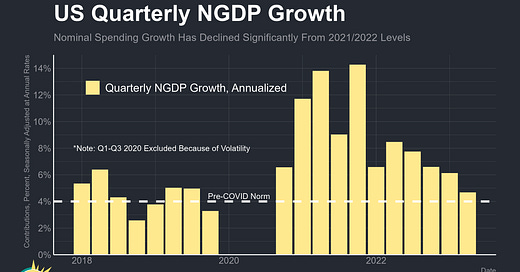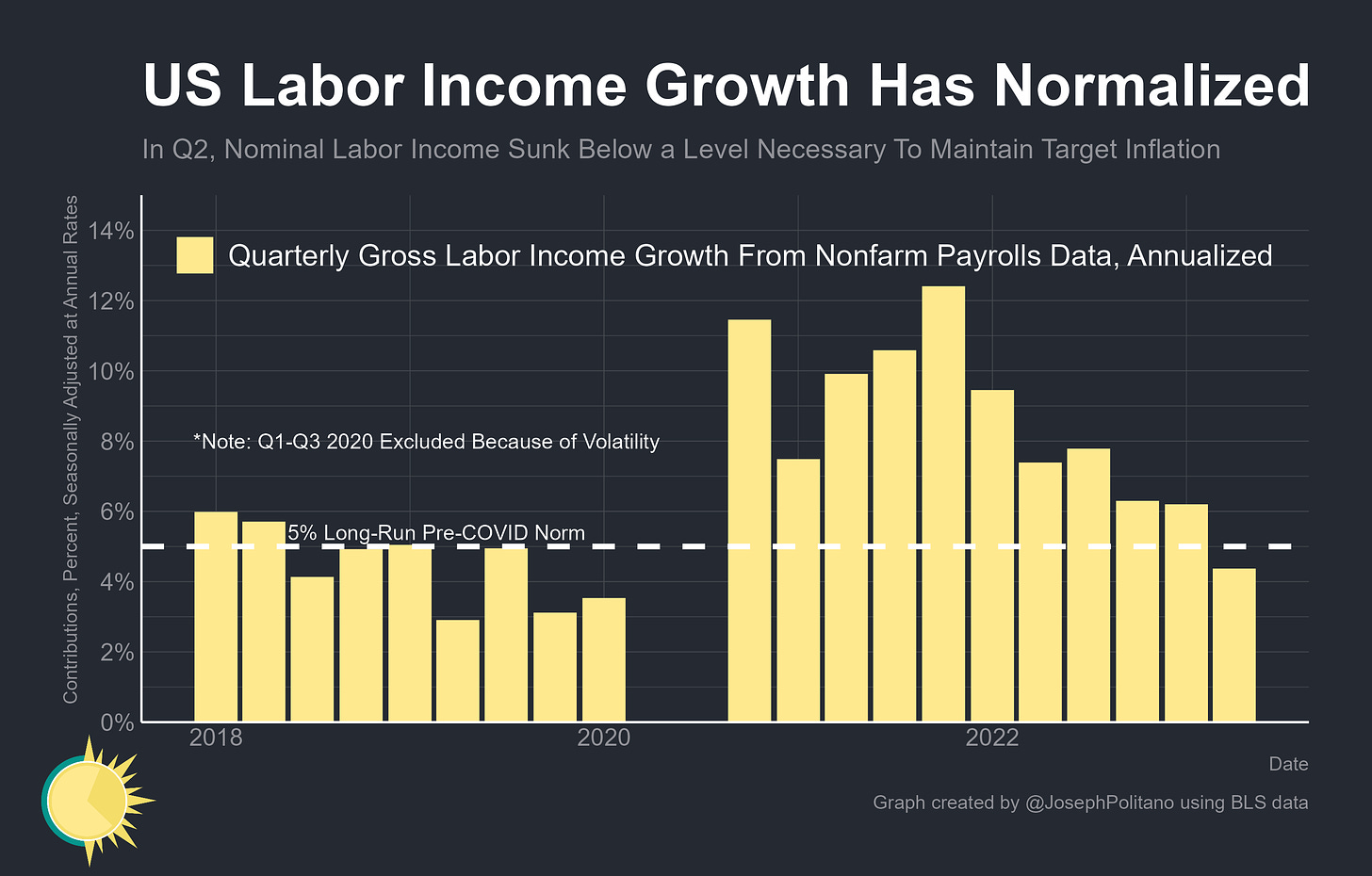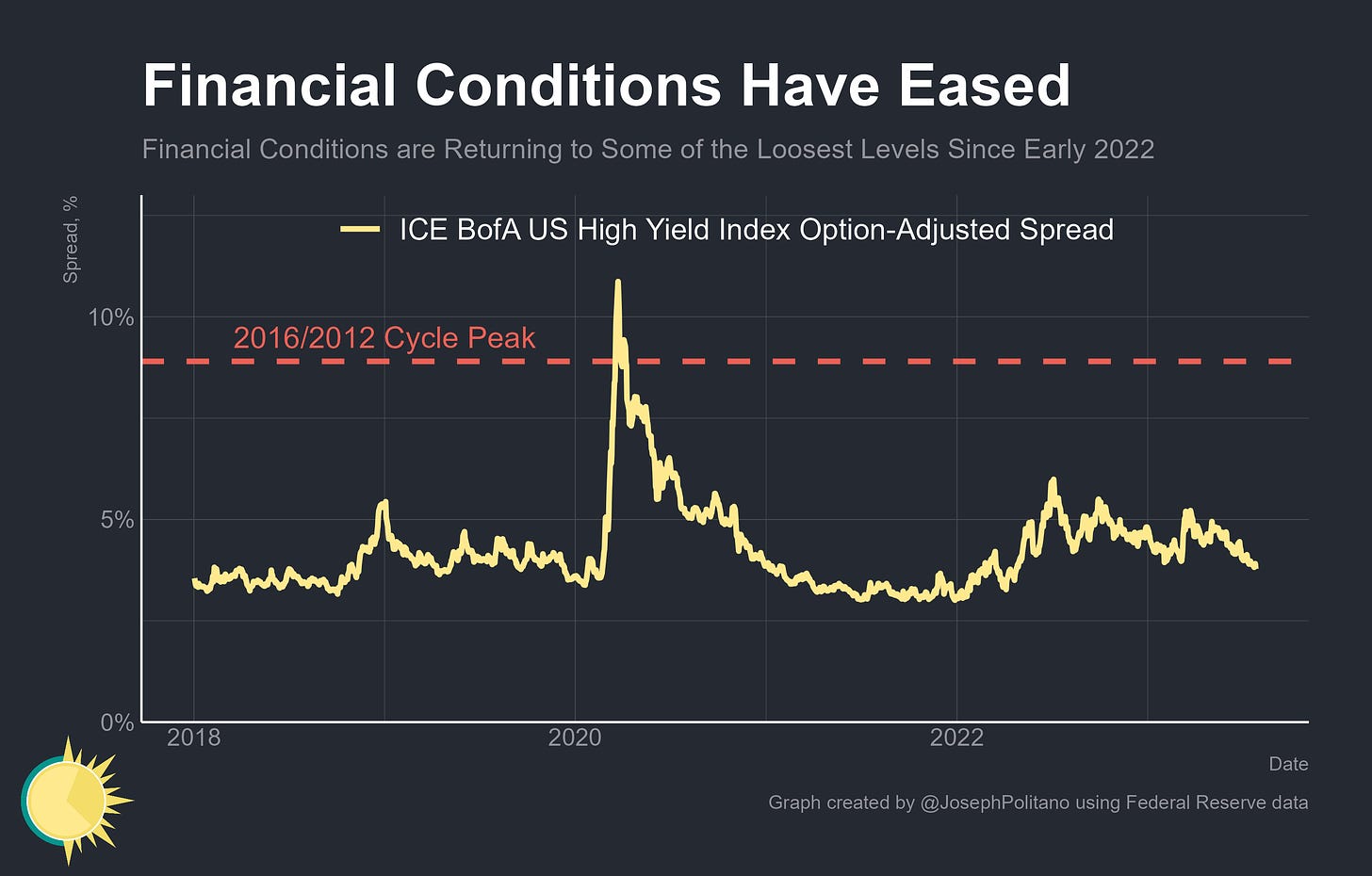Sticking the Soft Landing
Supply and Demand-Side Drivers of Inflation Have Eased Tremendously—Without a Recession
Thanks for reading! If you haven’t subscribed, please click the button below:
By subscribing you’ll join over 32,000 people who read Apricitas weekly
This week the Federal Reserve raised rates for the 11th time, bringing them to the highest levels seen since before the 2001 recession—yet they sounded the most optimistic they have been in years about the forward path of inflation. Neither the Fed staff, Jerome Powell, nor the consensus forecasts of the FOMC seem to believe a recessionary increase in unemployment is necessary to tame today’s inflation. It’s a far cry from last year, where base expectations implied a rapid recession, and monetary policymakers were quick to emphasize that the path to a “soft landing” where inflation fell without a recession was narrow if it even existed at all. That change in tone has been a direct response to a procession of recent economic data, nearly all of which came with strong positive news.
The Great Pandemic Inflation was driven by two principal factors: a “supply-side” crunch to real economic capacity thanks to the direct effects of COVID, supply-chain issues, and subsequent shocks like Russia’s invasion of Ukraine, plus a “demand-side” surge in household and consumer incomes and spending as a downstream consequence of generous fiscal policy and loose monetary policy. Headline inflation peaked this time last year, but as demand-side factors grew to overwhelmingly dominate the drivers of inflation core price growth has remained too strong for the Fed’s liking.
However, since summer 2022 we’ve seen a significant unwinding on both of those fronts—supply chain constraints have eased and energy prices have declined all the while nominal consumer spending and incomes have decelerated close to normal levels. The result is that Nominal Gross Domestic Product (NGDP), the dollar size of the US economy, has grown by only 6.3% over the last year, the lowest rate since Q1 2021, while Real Gross Domestic Product has grown by 2.6%, the highest rate since Q1 2022. That, combined, has been exceptional news for inflation—headline price growth in the Personal Consumption Expenditures Price Index (PCEPI) that the Fed targets has fallen under 3% and core inflation has fallen to 4.1%.
Yet even this understates the deceleration in inflationary pressures that has occurred over the last several months. At a quarterly annualized rate, NGDP growth is at the lowest level since the beginning of the pandemic and is now broadly in line with pre-COVID norms. Quarterly growth in nominal consumer spending likewise clocked in at the lowest level since 2019 and even below the Q3 2019 rate. Comprehensive wage data released Friday from the Employment Cost Index (ECI) showed nominal private-sector wages growing at a 4.1% annualized rate, the lowest since Q2 2021 and roughly in line with prior periods of strong wage growth seen in the late 90s and early 2000s. Economic renormalization is spreading across a variety of nominal growth and inflation indicators, from rent growth to consumer spending to the core services ex-housing prices the Fed continues to emphasize must cool for inflation to fully return to normal levels. That’s why the once-tepid optimism for a soft landing continues to rise.
The Labor Market & Inflation
Growth in US Gross Labor Income, the sum of aggregate wages and salaries in the economy, continues to decelerate towards normal pre-pandemic growth rates. That’s critical because of the extremely strong relationship between GLI growth and the highly cyclical components of inflation like housing rents. Using data from the Bureau of Economic Analysis, which incorporates growth in bonuses and employee stock options, wage growth has completely normalized, while two separate constructions of GLI growth from BLS data both show year-on-year growth 2.5% or less above pre-pandemic levels.
That deceleration in Gross Labor Income has been accompanied by a deceleration in aggregate consumer spending, growth of which has broadly fallen to pre-pandemic rates. Right now, Americans are spending 5.4% more dollars on consumption than they were in June 2022, the lowest pace of year-on-year growth since the early pandemic and below levels seen in late 2018. Importantly, consumer spending has actually decelerated slightly faster than Gross Labor Income growth as Americans run out of the excess savings that propelled so much growth in the early COVID spending recovery.
Yet the quarterly pace of Gross Labor Income growth has actually decelerated even further, falling below the pre-COVID norm in the most recent data for the first time since the start of the pandemic. Given that wage growth is slowing and the personal savings rate is recovering as Americans deplete their “excess savings,” we should expect some further decelerations in nominal consumer spending going forward.
Likewise, wage growth has decelerated to some of the lowest levels since the beginning of the pandemic. ECI data, which provides the highest-quality estimate of wages and salaries by using a fixed weighting of occupation and industry and therefore excluding variation caused by changes in employment levels, showed private-sector wages growing at a 4.1% annualized rate this quarter. Though just one quarterly print, that level is only slightly above what would be roughly consistent with 2% inflation if you presume the historic 2.2% rate of productivity growth America maintained before the Great Recession. Plus, the amount of wage disinflation achieved so far is larger than ECI suggests because of the rapid decline in the number of Americans changing jobs to work in better-paying industries and occupations.
Importantly, that decline in wage growth has occurred against a backdrop of unemployment rates remaining at some of the lowest levels in modern history. That low unemployment would produce high wage growth, which in turn would produce unsustainably high spending and runaway inflation through a fairly classic wage-price spiral, is part of the bedrock foundation of many Phillips curve models of the economy where unemployment must rise to quell excess demand-driven inflation. Those models, in turn, formed much of the basis of forecasts that implied a recession was necessary to get inflation under control. Yet over the last year, we have seen a rapid expansion of the US labor market—with nonfarm payrolls increasing by 3.8M and prime-age employment rates hitting 20-year highs—coinciding with significant deceleration in wage growth, spending growth, and inflation. Hence, the Fed and other institutions are walking back last year’s forecasts made under extreme versions of those Phillips curve models.
Rising Optimism for a Soft Landing
Likewise, this disinflation has coincided with a significant easing of financial conditions, notwithstanding the temporary tightening in the wake of Silicon Valley Bank’s failure earlier this year. Yield spreads on high-risk corporate bonds have now gradually declined to some of the lowest levels since the start of the Fed’s tightening cycle in 2022. Given that spreads partially reflect both the risk of recession and the effective tightness of corporate credit, it’s clear that businesses are finding financing easier to access and financiers are less worried about a downturn even amidst higher rates.
That easing of financial conditions has coincided with medium and long-run inflation expectations (derived from pricing on inflation-indexed treasury bonds) remaining within a range consistent with the Fed’s 2% inflation target. If anything, inflation expectations were too low over the last 9 months amidst fears of a recession, and the return of economic optimism has caused them to rebound back to appropriate levels. In particular, the growing strength of longer-term inflation expectations is a welcome development, even if it has only shown up for a few trading days—it means markets are less worried about a return of the kind of structurally weak demand environment we had during the 2010s.
The Long 2010s are Over
The story of the 2010s economy was primarily one of excessively tight monetary policy leading to persistent underinvestment, low employment, and sluggish growth. The difficulties in further loosening monetary policy when short-term rates were stuck at the zero lower bound—something Japan has struggled with for a generation—plagued the US for years, but they now feel like a distant memory with short-term rates above 5%. Indeed, in many ways, the United States has now left the stagnant political economy of the long 2010s completely behind us.
In contrast to the 2010s, the US economy has grown more since the start of the pandemic than essentially any major high-income economy bar Australia. Not only has real per-capita consumption recovered to pre-COVID levels, but it has actually broadly returned to its pre-COVID trend at the fastest pace of any modern recession—in stark contrast to the permanent scars on consumption left by the 2008 recession.
In fact, growth in real consumption of durable goods has not only vastly exceeded the pre-pandemic trend but briefly caught up with the pre-Great Recession trend, and remains high even as it hasn’t grown in several years. When you look at durable goods spending as a share of total household consumption, the 2010s could not stand out more—though the long-run trend is of extremely gradual decline as households get richer faster than their spending on goods grows, the 2010s saw durable goods’ share of spending sink by roughly 3% in 3 years and barely recover afterward. Not until the pandemic did durable goods consumption spending climb back to its pre-recession share of household budgets. That meant more than a decade of, effectively, household underinvestment in some of the most-important big-ticket items (cars, household appliances, phones, and computers) that provide long-term welfare and enhance people’s economic productivity—and that is being partially undone today.
Likewise, the long 2010s were a disaster for America’s industrial production and investment—US manufacturing output has still never returned to December 2007 levels, and it took more than 5 years before domestic fixed investment levels exceeded those of 2010. Post-COVID, the US is instead investing record amounts into manufacturing structures, thanks in large part to the preponderance of federal subsidies passed in the Inflation Reduction Act and CHIPS Act. In fact, nonresidential fixed investment has been a major contributor to the ongoing strength of the US economy, even as nominal spending cooled and residential fixed investment cratered in response to higher interest rates.
It’s not the only place where America’s economy is not only doing better than what it was pre-pandemic but better than what could be expected in a world completely absent a pandemic. For example, real median wages, adjusted for demographic shifts, are now actually slightly above the 2015-2019 trend growth rate. Our frame of reference matters tremendously, the 2010s were a historically terrible decade for growth, and 2018/2019 in particular represented a forgotten economic slowdown before the pandemic. To stick the soft landing, lots of growth indicators will not need to return to pre-pandemic “normal”—and in many ways, we should hope they do not.















I hope your wonderful treatises are read by Jerome Powell. If so, maybe we can get out of this mess! Thanks Joseph. A brilliant gentleman named Ophir Gottlieb frequently cites your graphs! Quite the cap feather I would say! Thanks for your hard study and work